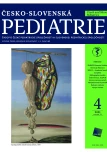Periodic fever syndrome, autoinflammatory diseases
Authors:
Fingerhutová Šárka; Doležalová Pavla
Authors‘ workplace:
Klinika pediatrie a dědičných poruch metabolismu, 1. lékařská fakulta Univerzity Karlovy a Všeobecná fakultní nemocnice v Praze
; Centrum vysoce specializované péče pro vzácná dětská revmatická a autoinflamatorní onemocnění ERN RITA
Published in:
Čes-slov Pediat 2023; 78 (4): 199-205.
Category:
Chapters for Specialization in Pediatrics
doi:
https://doi.org/10.55095/CSPediatrie2023/035
Overview
Autoinflammatory diseases (AID) include a diverse group of diseases defined by dysregulation of the innate immune system. Clinical manifestations of sterile inflammation include usually episodic fever with variable presence of organ involvement. A more detailed understanding of the etiopathogenetic background of AID opens new perspectives for targeted therapies. Disease activity control and prevention of organ damage are the main treatment goals. Multidisciplinary management of AID should be concentrated in specialised centers.
The best known group of AIDs,periodic fever syndromes,include Familial Mediterranean fever (FMF), Mevalonate kinase deficiency (MKD), Tumor necrosis factor receptor-associated periodic syndrome (TRAPS), Cryopyrin-associated periodic syndromes (CAPS) and Periodic fever with aphthae, pharyngitis and cervical adenitis (PFAPA ).
The article provides general information about the group of autoinflammatory diseases and the most common types of periodic fevers.
Keywords:
interleukin 1 – next generation sequencing (NGS) – Cytokines – fever – gene – autoinflammatory diseases – periodic fever syndrome
Sources
1. M cDermott MF, et al. Germline mutations in the extracellular domains of the 55 kDa TNF receptor, TNFR1, define a family of dominantly inherited autoinflammatory syndromes. Cell 1999; 97(1): 133–44.
2. de Jesus AA, et al. Distinct interferon signatures and cytokine patterns define additional systemic autoinflammatory diseases. J Clin Invest 2020; 130(4): 1669–1682.
3. Baldovino S, et al. Rare diseases in Europe: from a wide to a local perspective. Isr Med Assoc J 2016; 18(6): 359–63.
4. S attler S. The role of the immune system beyond the fight against infection. Adv Exp Med Biol 2017; 1003: 3–14.
5. N igrovic PA , Lee PY , Hoffman HM. Monogenic autoinflammatory disorders: Conceptual overview, phenotype, and clinical approach. J Allergy Clin Immunol 2020; 146(5): 925–937.
6. S avic S, Caseley EA, McDermott MF. Moving towards a systems-based classification of innate immune-mediated diseases. Nat Rev Rheumatol 2020; 16(4): 222–237.
7. S angiorgi E, Rigante D. The clinical chameleon of autoinflammatory diseases in children. Cells 2022; 11(14).
8. Ben-Chetrit E, et al. Consensus proposal for taxonomy and definition of the autoinflammatory diseases (AIDs): a Delphi study. Ann Rheum Dis 2018; 77(11): 1558–1565.
9. L i Y, Yu M, Lu M. Pathophysiology, clinical manifestations and current management of IL-1 mediated monogenic systemic autoinflammatory diseases, a literature review. Pediatr Rheumatol Online J 2022; 20(1): 90.
10. R owczenio DM, et al. Late-onset cryopyrin-associated periodic syndromes caused by somatic NLRP3 mosaicism-UK single center experience. Front Immunol 2017; 8: 1410.
11. D i Donato G, et al. Monogenic autoinflammatory diseases: state of the art and future perspectives. Int J Mol Sci 2021; 22(12).
12. F ingerhutova S, et al. Periodické horečky a jiná autoinflamatorní onemocnění. Cas Lek Cesk 2018; 157(3): 122–129.
13. F ingerhutova S, Krol P, Dolezalova P. Diagnostická úskalí PFAPA syndromu. Vox pediatriae 2017; 6: 24–28.
14. O bici L, Merlini G. Amyloidosis in autoinflammatory syndromes. Autoimmun Rev 2012; 12(1): 14–7.
15. O zen S, et al. Results from a multicentre international registry of familial Mediterranean fever: impact of environment on the expression of a monogenic disease in children. Ann Rheum Dis 2014; 73(4): 662–7.
16. R omano M, et al. The 2021 EULAR/American College of Rheumatology points to consider for diagnosis, management and monitoring of the interleukin- 1 mediated autoinflammatory diseases: cryopyrin-associated periodic syndromes, tumour necrosis factor receptor-associated periodic syndrome, mevalonate kinase deficiency, and deficiency of the interleukin-1 receptor antagonist. Arthritis Rheumatol 2022; 74(7): 1102–1121.
17. F ingerhutova S, et al. Péče o pacienty s autoinflamatorními onemocněními: Česko-slovenská adaptace překladu evropských doporučení SHARE. Čes- -slov Pediatr 2018; 73(4): 209–220.
18. A marilyo G, et al. Consensus treatment plans for periodic fever, aphthous stomatitis, pharyngitis and adenitis syndrome (PFAPA ): a framework to evaluate treatment responses from the childhood arthritis and rheumatology research alliance (CARRA) PFAPA work group. Pediatr Rheumatol Online J 2020; 18(1): 31.
19. L antto U, et al. Long-term outcome of classic and incomplete PFAPA (periodic fever, aphthous stomatitis, pharyngitis, and adenitis) syndrome after tonsillectomy. J Pediatr 2016; 179: 172–177 e1.
20. Vanoni F, Theodoropoulou K, Hofer M. PFAPA syndrome: a review on treatment and outcome. Pediatr Rheumatol Online J 2016; 14(1): 38.
21. M arino A, et al. Periodic fever syndromes and the autoinflammatory diseases (AIDs). J Transl Autoimmun 2020; 3: 100031.
22. Welzel T, Kuemmerle-Deschner JB. Diagnosis and management of the cryopyrin-associated periodic syndromes (CAPS): What do we know today? J Clin Med 2021; 10(1).
23. C udrici C, Deuitch N, Aksentijevich I. Revisiting TNF receptor-associated periodic syndrome (TRAPS): current perspectives. Int J Mol Sci 2020; 21(9).
24. Georgin-Lavialle S, et al. Systemic autoinflammatory diseases: Clinical state of the art. Best Pract Res Clin Rheumatol 2020; 34(4): 101529.
Labels
Neonatology Paediatrics General practitioner for children and adolescentsArticle was published in
Czech-Slovak Pediatrics

2023 Issue 4
Most read in this issue
- Periodic fever syndrome, autoinflammatory diseases
- Current trends in the management of inguinal hernia in children
- Spinal muscular atrophy in newborn
- The use of contrast-enhanced ultrasound in diagnosis of liver tumors in newborns
